Dana Vrajitoru
B583/C490 Game Programming and Design
Collision Detection
Collision Detection
- For any two objects that are close enough, we need to detect if
their surfaces intersect.
- We can prevent an object in the scene from moving forward if there
is an intersection.
- If the objects are a collection of polygons, we need to compute
the possible intersection of each polygon from one object with all
polygons from the other.
- This is usually very time consuming.
Collision Meshes
- Many game engines will allow (or require) the user to define a
collision mesh for any object in the scene for which we need to detect
the collision with other objects.
- The collision meshes are not displayed. They are only used to
compute intersections with other objects instead of the polygons
composing the object.
- The collision meshes are defined to make the computation easier:
boxes, spheres, cylinders. The fastest test is the one you don't do.
Coplanar Polygons Intersection
- Two coplanar polygons intersect if at least one vertex from one is
inside the other polygon, or if at least two edges of the polygons
intersect.
- Suppose we have a convex polygon and a point inside the polygon
(center). Then an arbitrary point is inside the polygon if it's on the
same side as the center of all the lines composing the polygon.
- Each polygon can be decomposed in triangles and the intersection
computed for each couple of triangles.
Polygons Intersections
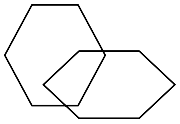
| 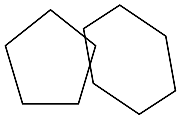
|
| Both polygons have vertices inside the other
| Only one polygon has a vertex inside the other
|
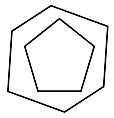
| 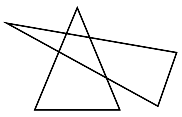
|
| No edge crossing
| No vertex is inside any of the polygons
|
Inside a Polygon
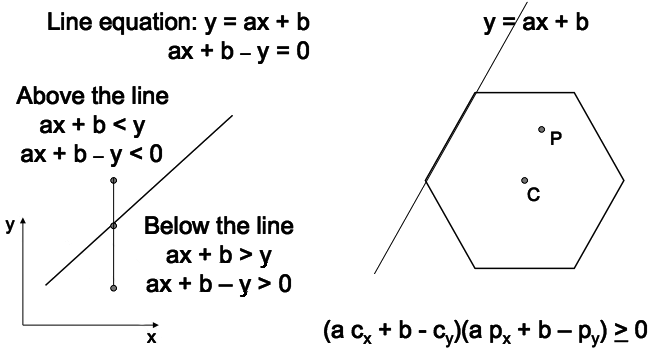
Edges Intersection
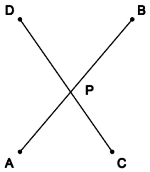
Equations of the two lines:
(Px - Ax)/(Bx - Ax) =
(Py - Ay)/(By - Ay)
(Px - Cx)/(Dx - Cx) =
(Py - Cy)/(Dy - Cy)
By solving these we find P.
P must be between A and B and between C and D on the lines:
(Px - Ax)(Px - Bx) < 0
(Px - Cx)(Px - Dx) < 0
Only one coordinate needs to be checked because the points are
colinear.
Both the vertex check and the edge check are O(n2),
where n is the number of vertices in the highest polygon.
Two-Phase Algorithms
- In a scene with m objects, the algorithm must compute
O(m2) intersection of pairs of objects.
- A two-phase algorithm eliminates most of the collision
computations based on bounding boxes/spheres, etc. This is called the
broad phase.
- For moving objects, one can compute the bounding box of the entire
movement in the unit of time.
- To eliminate some of the intersection, a hierarchical tiling of
the space can be used (quad tree), or a coordinate sorting.
- This phase can be made almost O(m) (linear).
Swept Volume for a Moving Object
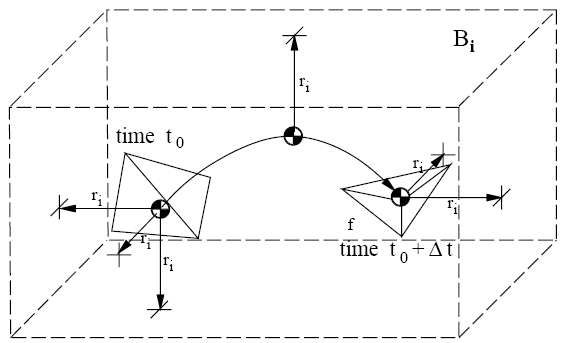
From B. Mirtich (1997): Efficient Algorithms for Two-Phase Collision
Detection, Technical Report TR-97-23, Mitsubishi Electric Information
Technology Center America.
Coordinate Sorting
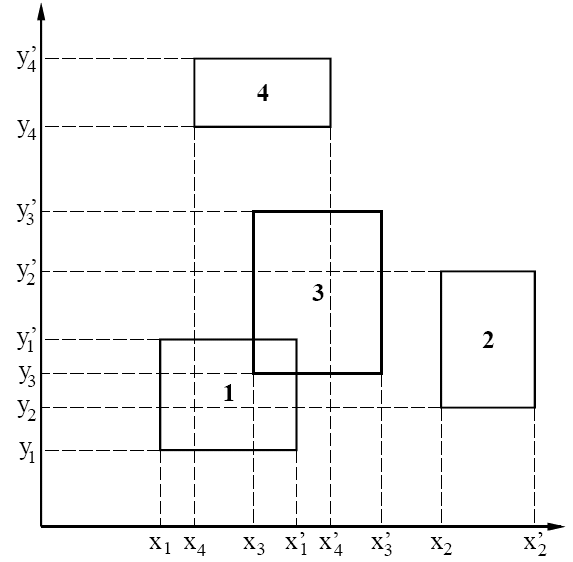
A hash table can be used to improve the sorting.
Narrow Phase Collision
- Analyzes more carefully pairs of coordinates that are not culled
by the broad phase.
- Some of them would return the distance between non-intersecting
objects that can be used in movement planning.
- Some optimizations
Lin-Canny Algorithm
- Lin-Canny closest features algorithm determines the closest faces
/ edges / vertices between two polyhedral objects.
- It uses the Voronoi regions for each feature (see next slide). Let
F be a feature and V(F) its Voronoi region.
- If A and B are the closest features of two polygons, and a and b
the closest points in each feature, then a is in V(B) and b is in
V(A).
- The algorithm iteratively reduces the current closest features.
- Alternatives exist that consider the coherence of the scene over
time.
Voronoi Regions
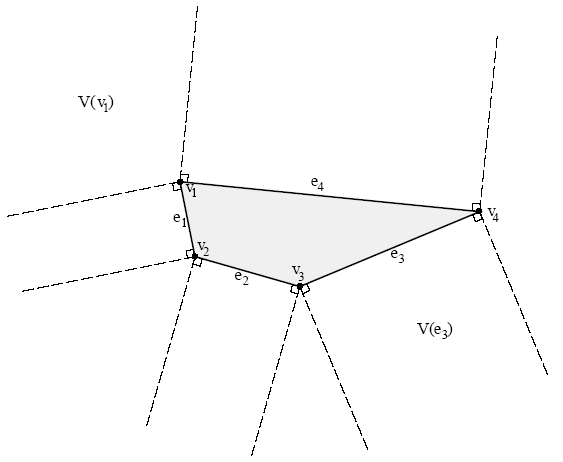
Lin-Canny Algorithm
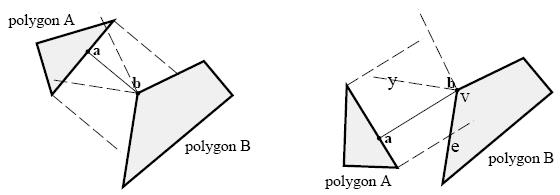
Other Algorithms
- V-Clip Algorithm - an improvement of the Lin-Canny algorithm, also
using the Voronoi regions.
- GJK (Gilbert, Johnson, Keerthi) - simplex-based algorithm. It
considers the polyhedra as clouds of points and computes a simplex
(point, bounded line, triangle, or tetrahedron) as a bounding region
of the Minkowski difference polyhedron (or TCSO).
- The TCSO (transitional configuration space obstacle) is a
collection of vectors obtained from the difference of points from the
two polyhedra.
TCSO = {b-a | a is in A and b is in B}.
- Public libraries for collision-detection are available, like
I-Collide, V-Collide, QHull, ColDet.
3D Intersections
- Plane equation: ax + by + cz + d = 0
- The two sides of the plane are defined by
ax + by + cz + d < 0
ax + by + cz + d > 0
- Two points P and Q are on different sides of the plane if
(a Px + b Py + c Pz + d) * (a
Qx + b Qy + c Qz + d) < 0
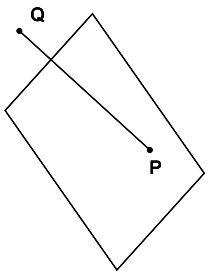
Movement through a Polygon
- By moving an object by a certain vector in the scene, the object
may go to the other side of the polygon.
- In this case we have to determine if the line segment between the
two object positions crosses the polygon.
- We must compute the intersection point of the line and the plane,
then verify that it's inside the line segment and inside the polygon.
Crossing a Polygon
- First we must check that the origin O and the destination D are on
different sides of the plane.
- Plane: ax + by + cz + d = 0
- Line segment:
D = O + (t Lx, t Ly, t Lz)
where L is the direction vector
- P the intersection point is defined as satisfying both the plane
and the line segment equations.
- Then we must check that P is inside the polygon based on the
equations described before.
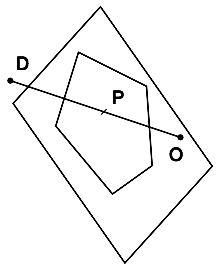
Non-Coplanar Polygons
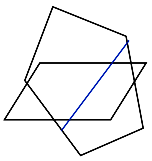
- Compute the intersection line based on the plane equations.
- Check if the line intersects any of the polygons.
- If it intersects both, then a point on this line must be on an
edge of one polygon and at the same time inside the other one.
Box - Sphere
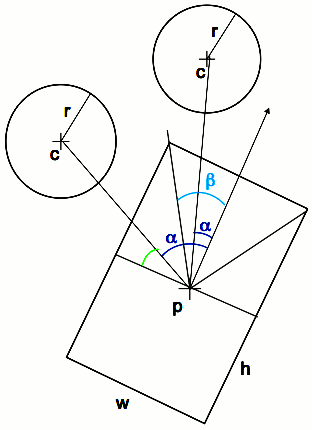
- Maximum distance at which we can still have an intersection
max = r + sqrt(w2 + h2)/2
If d(c, p) > max, we don't need to check for collision.
- The collision threshold thr can be computed as:
If alpha < beta:
thr = r + (h/2) cos alpha
else
thr = r + (w/2) / cos (90-alpha) = r + (w/2) / sin alpha
- Linearizing the computation to avoid the sin/cos.
- Let dg = sqrt(w2+h2)/2
- If alpha < beta:
thr = r + h/2 + (alpha/beta) (dg-h/2)
else
thr = r +w/2 + ((alpha-beta)/(90-beta) (dg - w/2)
- Note: the intersection is computed in the XZ plane because both
objects are bound to the ground (terrain).
Moving Past a Sphere
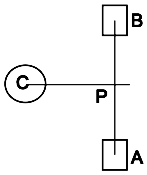
- When the sled moves from A to B in one frame, it may collide with
a snowball on the way.
- We have to project the ball's center on the movement line, and if
the distance to the line is less than the max and P is between A and
B, then we must compute the collision between the objects at the point
P.
- The distance between C and a line of equation ax + bz + c = 0 is
(a cx + b cz + d)/sqrt(a2+b2)
Motion and Collision
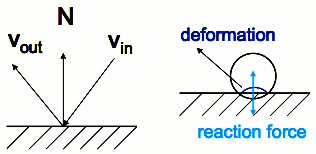
- When an object hits a surface with a certain velocity, it may
bounce from the surface depending on the object elasticity.
- A perfectly elastic object bounces from a surface with a speed
equal to its original speed, but in a direction symmetric with respect
to the surface normal.
Imperfect Bouncing
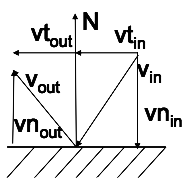
- If the object is not perfectly elastic, then part of the energy
resulting from the collision is absorbed.
- The speed can be decomposed in a vector tangent to the surface and
one normal to the surface.
- The tangent component doesn't change.
- The normal component is partially absorbed by a factor e depending
on the two surfaces.
- vout = vtout + vnout =
vtin + e vnin
- If |N|=1, then vnin = N vin
(scalar product)
- vtin = vin - vnin




















